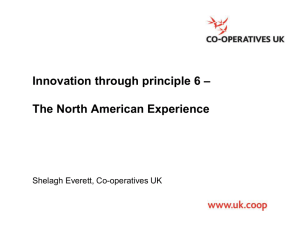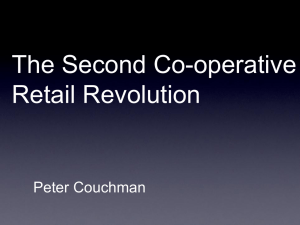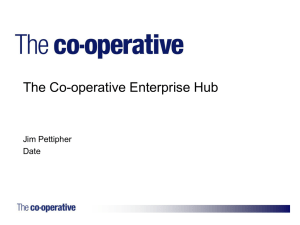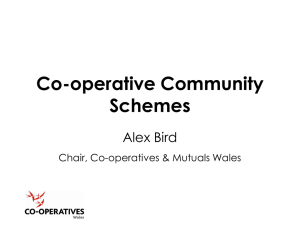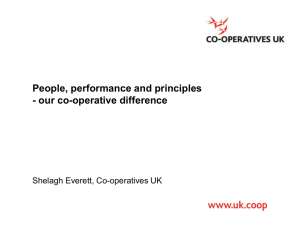Co-operative societies in society classifications and incorporation
advertisement
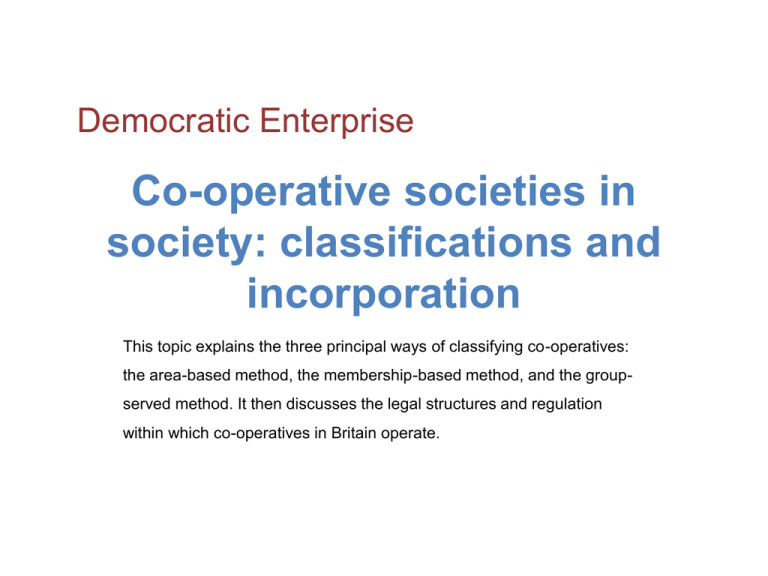
Democratic Enterprise Co-operative societies in society: classifications and incorporation This topic explains the three principal ways of classifying co-operatives: the area-based method, the membership-based method, and the groupserved method. It then discusses the legal structures and regulation within which co-operatives in Britain operate. Learning Goals • identify the different types of co-operatives; • assess the advantages and disadvantages of various methods of classification; • recognise the legal structures that apply to cooperatives. Key Arguments • Co-operatives are classed in different ways: by area, by membership, and by group served. • Co-operatives are most commonly classed according to the type of group served. • The group-served method distinguishes between consumer cooperatives, producer co-operatives, worker co-operatives, and hybrid co-operatives. • There is a legal framework for establishing and running a cooperative. Introduction Co-operatives are a diverse and flexible enterprise model but attempts have been made to appropriately classify them. Three of the more common methods are: • by area • by membership • by group Area-based method of classification Area served Local: Regional: National: International Drumchapel Credit Heart of England Scotmid – is the Mondragon CoUnion – serves a – is a consumer largest operative local community in society serving independent coCorporation – the west end of the midlands of operative in has plants in 18 Glasgow city. England, in Scotland and has a countries outside particular the wide portfolio of of Spain. regions of businesses. Coventry and Warwick. Membership-based method of classification Type of membership Primary co-operative (centralised) Secondary co-operative (federated) Provide direct services to Membership of a patron-users (i.e. secondary co-operative members). consists of other coAn example of a ‘primary operatives. co-operative’ would be GreenCity Wholefoods, a worker co-operative based in Glasgow. An example of a ‘secondary co-operative’ is the Co-operative Retail Trading Group (CRTG), who acts as a wholesaler for all of the independent co-operative retail societies in the UK. Mixed Some co-operatives (usually regional) can supply services to individual members as well as other co-operative businesses. An example of a ‘mixed cooperative’ would be the Cooperative Group, which admits into membership individuals as well as other businesses. Group-served method of classification (1) The ‘group served’ method is the most widely-used method of classifying co-operatives. Within each of the group categories (producers, consumers, workers, and hybrid) there are co-operatives that focus on different areas of activity, such as marketing, or housing, or insurance. Group-served method of classification (2) Group served Producers Consumers Marketing Retail Production supply Credit Service Health Credit Insurance Housing Workers Hybrid Can be any form of Serves business once it is more owned and groups democratically controlled by its employees two or different Mutual insurance Community Machinery ring Note that the above examples are merely representative of the type of businesses co-operatives can be rather than a definitive list. Producer co-operatives Producer owned businesses enable self-employed people and businesses to gain the strength in numbers they need to survive in the market. An example of a producer co-operative would be a group of farmers banding together to market their produce jointly. Case study - Ocean Spray Ocean Spray is an agricultural co-operative owned by more than 600 cranberry growers across North America and Canada and over seventy Florida grapefruit growers. The co-operative was formed in 1930 by three cranberry growers who shared a common goal of expanding the market for their crops through innovative products. Ocean Spray is a type of enterprise known as a marketing co-operative. This means that Ocean Spray’s owners use the co-operative for joint marketing and production operations. Each farmer will supply their produce to Ocean Spray which offers the highest price it can as well as guaranteeing to purchase all of their members’ produce. Ocean Spray then markets and sells the farmers’ inputs through a wide range of products, including juices, dried fruit and sauces. Consumer co-operatives Consumer owned businesses provide people with goods at the lowest possible price, with a guarantee of good value, and so make their income go further. An example of a consumer co-operative would be a retailer serving a local community with food and toiletries. Case study - The Co-operative Group The Co-operative Group, headquartered in Manchester, England, is the UK’s largest consumer co-operative. Operating across multiple industries and with revenues of £13.7bn in 2010, the group is one of the most successful retail co-operatives in the world. The group has operations in the food, financial services, travel, pharmacy, funeral care, legal services, electrical goods, and motor vehicles industries. Central to the success of the Co-operative Group is the collective ownership structure of the business, whereby only those who trade with the cooperative can be owners. And as owners, members are entitled to a share of the profits generated by the business based on their patronage. Worker co-operatives Worker owned businesses provide people with an income, but also are a way of gaining control over the conditions under which they labour, providing what the International Labour Organisation calls ‘decent work’. A worker cooperative is a business that is jointly owned and democratically controlled by those who work for the company. Case study – Suma Wholefoods Triangle Wholefoods Collective Limited, trading as Suma Wholefoods, is the UK’s largest worker co-operative (where the members of the business are employees). Based in Elland, near Halifax, the company has over 120 members and a turnover of £25m. Not only do the worker-members collectively own the company and have the right to participate in a share of the profits generated, they also act as the ultimate governing body in the business through a non-hierarchical management structure. The organisation has a two tier structure for governance, with the members electing a Management Committee at the Annual General Meetings (AGM). The Management Committee is delegated decision making responsibility for the company and is accountable to the members. Hybrid co-operatives (1) A hybrid co-operative (also known as a multi-stakeholder co-operative) is defined as a multi-member class co-operative that has its own distinct rules regarding membership, governance and patronage. For example, Eroski supermarket, part of Mondragón, has both workers and consumers as its members. Hybrid co-operatives draw on the strengths and eliminate the weaknesses of different cooperative enterprises: consumer co-operatives are scalable and highly adept at raising capital, whereas worker co-operatives are committed to providing satisfying, rewarding employment for workers. Hybrid co-operatives (2) There are three major factors in the structure of a hybrid co-operative: • Membership – What are the rules governing how different stakeholders become members e.g. should worker members contribute more capital and undergo a period of probation? • Governance – How should members be represented on the board i.e. equally or by some other proportional mechanism? • Patronage – Should each membership class receive the same proportion of the surplus generated? Advantages/Disadvantages of Hybrids? Legal regulation Under UK legislation, co-operatives have a variety of options regarding the legal form for the enterprise. Three of the common legal forms are: • Industrial and Provident Society (IPS) • Private company limited by guarantee • Private company limited by shares There are other legal forms co-operatives can adopt, such as those that enable the creation of community benefit co-operatives (known as BenComms) or charitable organisations. Industrial and Provident Society (1) An Industrial and Provident Society (IPS) is an organisation conducting an industry, business or trade, either as a co-operative or for the benefit of the community, and is registered under the Industrial and Provident Societies Act 1965. Companies that wish to set up as an industrial and provident society must register with the Financial Services Authority. Traditionally, co-operatives were set up under this act because their unique ownership and governance structures were viewed as incompatible with registration under the Companies Act. Industrial and Provident Society (2) The Industrial and Provident Societies Partnership Act 1852 (predates the act for investor-owned companies by four years). A society may register as an Industrial and Provident Society if it satisfies either of the two conditions found at Section 1 (2) of the Industrial and Provident Societies Act 1965: • The society is a bona fide co-operative Or • Special reasons (benefit of the community) Bona fide co-operative (1) No legal or statutory definition! There are some agreed conditions however: 1. The members of the co-operative must have a common economic, social or cultural need/interest. 2. The purpose of the co-operative is to operate for the mutual benefit of its members. 3. The co-operative is jointly owned by the members and is democratically controlled based on a system of one member/one vote. 4. There is a limited return (if any) on share and loan capital. 5. The members of the co-operative receive their share of the co-operative’s profit in proportion to their participation in the business. 6. There should be no discriminatory restrictions on membership. Bona fide co-operative (2) These conditions were designed in such a way so as to reflect the ICA Statement on the Co-operative Identity. Industrial and Provident Society (3) IPS co-operatives are regulated by the Financial Services Authority (FSA) but are not subject to stringent regulations; doesn’t have any strong powers except the ability to cancel registration of a cooperative if enough members vote to do so. IPS legislation is out-of-date (new act passed in 2010 but not yet law) and places restrictions on co-operatives, especially in relation to raising capital: • Individual members can only provide a maximum of £20,000; • Business members can provide up to £40,000. Company Limited by Guarantee (CLG) Companies limited by guarantee do not have any share capital in the business and members act as guarantors rather than shareholders. At the time of incorporation, members agree to cover a certain amount of the assets of the company (usually £1) in the event of the business being wound up. This legal form is most common amongst charitable and voluntary organisations but has been utilised by cooperatives, particularly worker co-operatives, since it is thought to provide strong protection for the values and principles of the business. Example of co-operative CLG The Very People, a marketing co-operative based in Glasgow, Scotland, adopted the CLG model after advice and consultation from Co-operative Development Scotland (CDS). The six members do not hold any shares in the business and operate a one member/one vote governance system. Company Limited by Shares (CLS) Companies limited by shares are prohibited from selling their share publically but still retain the ability to raise capital from external sources. The liability associated with these shares only relates to the value of the unpaid amount on the shares in the event of the company winding up. Example Harness Care Co-operative, a health care practice operating in the Brent area of Greater London, registered as a company limited by shares in 2008. CLG or CLS? Companies limited by guarantee are unable to issue equity shares, restricting their ability to raise capital. While most co-operatives do not choose the limited by shares legal form, it is possible to operate a one member/one vote governance system by issuing non-voting shares in the co-operative. There is a danger however, that members will seek to maximise the value of the co-operative in order to realise the capital gains accrued by their non-voting shares. Analysis of corporate legal structures Sole trader Advantages Easy and inexpensive Easy to organise to organise Partners share Owner has complete control control Partners receive all Owner receives all income Owner has unlimited liability Disadvantage s Partnership Owner is taxed on all business profits Not suitable for large or complex businesses income Corporation Owners have limited liability Large pool of investors and easier to raise capital Industrial and Provident Society Owners have limited liability Democratic governance structure Business life is perpetual Business life is perpetual Some partners have Complex and Limited return on unlimited liability costly to organise capital Partners are taxed on all business profits Double taxation (corporate profits and dividends) Difficult to raise external capital in the form of equity Personality differences may cause problems Owners have little control Limits on the amount members can invest Factors influencing the choice of legal form 1. A business must carefully assess its financial and administrative needs before choosing a legal structure (capital or labour intensive?). 2. Ridley-Duff and Bull argue that ‘the social identity of the owners (investors, consumers or employees) radically transforms the way the organization is run, and the way the benefits of ownership and trading are distributed.’ – IPS – close affinity with values and principles. – CLG – ability to pool resources and expertise (common for service oriented producer co-operatives). Summary • There are different ways of classifying co-operatives but the most common method is by user served. • Co-operatives have a variety of legal forms under which to incorporate as well as structures for community-benefit co-operatives and charitable organisations. • There are numerous benefits and disadvantages to each legal form and a clear understanding of the co-operative’s financial and administrative needs is required to select the appropriate structure. • Different legal forms protect the interests of the holders of power in an organisation; a co-operative must ensure that the members of the business are recognised by the chosen legal form. Resources and Support Mutuals Register https://mutuals.fsa.gov.uk/. Companies House http://www.companieshouse.gov.uk. Co-operative and Community Benefit Societies and Credit Unions Act 2010 http://www.legislation.gov.uk/ukpga/2010/7/content s. References and Reading Atherton, J., J. Birchall, E. Mayo, and G. Simon. Practical Tools for Defining Cooperatives. Manchester: Co-operatives UK, 2011. Co-operatives UK. Simple Legal (2nd edition). Manchester: Co-operatives UK, 2009. Co-operatives UK. Simple Finance. Manchester: Co-operatives UK, 2011. Financial Services Authority. Annual Report of the Registry of Friendly Societies 2000–2001. London: Registry of Friendly Societies, 2002. Ridley-Duff, R. ‘Cooperative Social Enterprises: Company Rules, Access to Finance and Management Practice’ Social Enterprise Journal 5 (2009): 50– 68.
